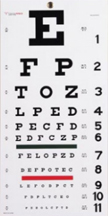
The Origins of Visual Acuity Testing
Anyone can recognize the famous eye chart as a symbol of vision care. Even in the 21st century, it persists as the most standard and popular method of visual acuity measurement. However, what are the origins of this staple chart?
Dr. Hermann Snellen, 1834-1908, is the Dutch ophthalmologist credited with the creation of the standard visual acuity test. Snellen’s colleague and mentor in the 1860s,
Dr. Fransiscus Donders, began instructing patients to stand a certain distance from a lettered chart and recite the characters they could clearly discern. Donders’s success with the lettered chart saw a necessity for a formal copy of the method, so he requested that Snellen create an official chart that would be permanently incorporated into his practice. With Snellen’s formal creation of the eye chart, many eye doctors saw a new opportunity for standardization. In addition, Snellen’s use of the fractional diagnosis was standardized, with 20/20 being the diagnosis for normal vision. The new “Snellen chart” and fractional diagnosis would allow patients to visit different doctors but still remain confident that each diagnosis was not only accurate, but also consistent.
New technology, such as the M&S Smart System, has enormously advanced the success of Snellen’s original eye chart. Now that visual acuity charts are computerized, fully randomizable features are possible. This ensures a more accurate diagnosis due to the patient’s inability to memorize a specific sequence of characters. In addition, computerized systems have added the versatility of movement that Snellen’s paper eye chart lacked. A digital system’s capability for moving targets and animations enables the diagnosis of many various disorders. In today’s world of vision care, computerized acuity tests are the most practical and adaptable option for vision testing. However, we still recognize and thank Dr. Snellen for his momentous contribution of the eye chart.
Source: American Academy of Ophthalmology
Have a thought about this article? Contact Us and let us know.